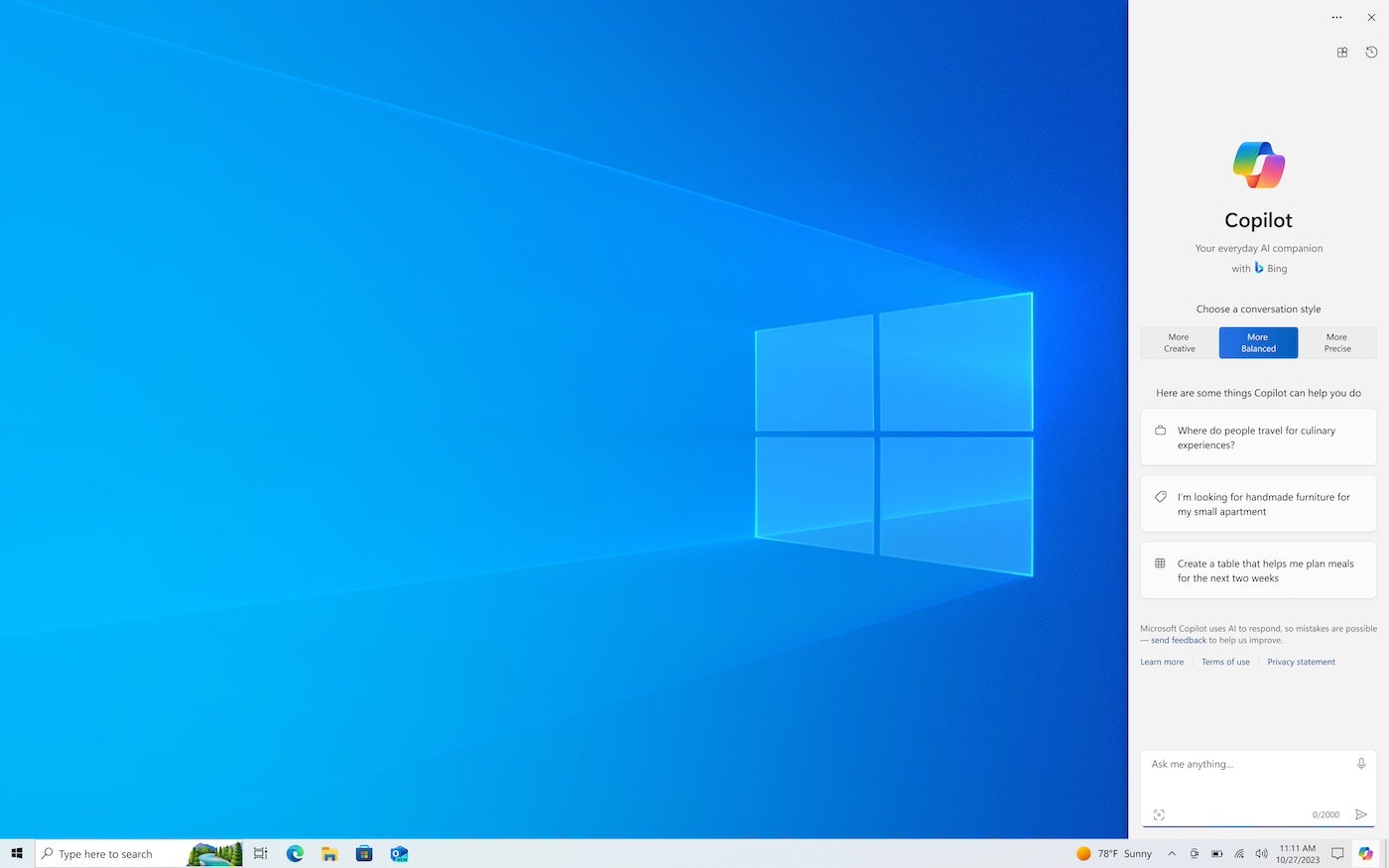
A surprise update from Microsoft adds artificial intelligence to older PCs.
Microsoft is bringing a preview of its generative AI Copilot tool to Windows 10 for businesses and home users to start; Copilot will come to managed PCs later when IT pros get the tools to support and manage it.
While Copilot won’t be in today’s Windows 10 update, as it requires additional testing before release, Microsoft will be using it to refine the update experience for what it calls “seekers,” adding a new Get The Latest Updates As Soon As They’re Available toggle to Windows Update. Selecting this will opt you into early access to non-security updates, including Windows Copilot as soon as it is available.
The arrival of Copilot in Windows 10 isn’t changing the operating system’s end-of-life date, which is still scheduled for Oct. 14, 2025. Microsoft is describing this release as about “bringing the value of AI and specifically Copilot” to Windows 10.
Jump to:
During his Microsoft Ignite keynote on Nov. 15, Microsoft CEO Satya Nadella called this the “age of copilots.” Microsoft is now delivering its AI assistants to places we weren’t expecting; Windows Copilot is coming to Windows 10 (Figure A).
Figure A
When Microsoft rolled out the 22H2 update to Windows 10 in October 2022, it was expected to be the last major update to Windows 10 before its support lifecycle ends in 2025. Microsoft has announced that it is bringing at least some of the features of its Copilot AI assistant to Windows 10, launching it in a Windows Insider build, as well as teasing possible additional changes in the future. However, the arrival of this update doesn’t mean that Microsoft is changing when support ends.
Microsoft’s growing family of Copilots launched in February 2023 as Bing Chat, which has since been rebranded as part of Microsoft’s suite of AI assistant tools. It builds on top of Microsoft’s OpenAI partnerships and the GPT-series of large language models, delivering on Microsoft’s long-held ambition of adding natural user interfaces to Windows. Windows Copilot uses a mix of GPT’s language parsing capabilities and its summarization tools to give answers to questions, using the database behind the Bing search engine as a source of information beyond GPT’s own training data, with other data sources and services where needed.
As a result, it has been rolling out different Copilots, focusing on specific tasks: coding, business applications, security and more. Copilot for Windows is intended to help you find things on and about your PC that you might not find by other means, where they might be buried several layers down in Settings, as well as give you quick access to chat-powered services. Windows 11’s Copilot rolled out as part of the 22H2 Moment 4 update earlier this fall, with access to Bing search and to a subset of Windows features and system applications. You can use it to open tools like Focus or change between light and dark modes.
Access to the preview of Windows Copilot in Windows 10 will be via a non-security update, initially for Windows Insiders in the Release Preview channel. There are hardware limitations, too: You will need at least 4 GB of RAM and a 720p display to use Copilot. Not all countries will get access to this first release, with it being limited to North America and parts of Asia and South America.
The initial release will only be available for consumer PCs that have opted in to the Windows Insider program, applicable to Home and Pro installs that aren’t managed by an IT department. This will allow IT professionals to try it out on sandboxed PCs before Microsoft makes it available to all Windows 10 devices.
Like the Windows 11 Copilot, the Windows 10 version will be an embedded web view launched via a Copilot button in the taskbar. Unlike Windows 11, this button will be at the far right of the taskbar, next to the date and time. Click the button, and Copilot will open on the right of your screen without overlaying your other windows, which will be resized and moved.
You will be able to open Copilot using the familiar Win C shortcut used to launch Cortana.
Not all the features and skills in the Windows 11 version of Copilot will be available in the Windows 10 version of the AI assistant because the APIs those features use aren’t part of Windows 10, and there are no plans to add them. Where APIs are available, additional skills will be added in future updates to Windows 10’s Copilot. Other Copilot features that depend on Windows 11 hardware capabilities are unlikely to be delivered because Microsoft can’t guarantee their availability on older devices.
One important aspect of this update is that many Windows Copilot features depend on information that’s associated with a user’s Microsoft account. An account wasn’t necessary for Windows 10, so users will need to create one to get the most from the service.
While adding Copilot to Windows 10 is an unexpected change, it’s one that makes sense for Microsoft and its users. Adding AI to Windows 10 will give older PCs a new lease of life, and Microsoft will get more data on how people use AI while refining its growing natural language capabilities.
More news from Microsoft Ignite: Microsoft Copilot Announced for Azure and New Solutions Offer More Security and Productivity from Windows in the Cloud